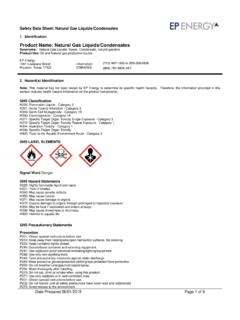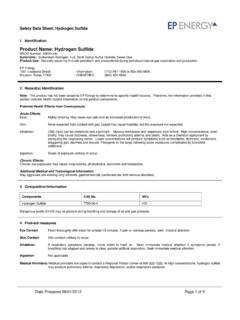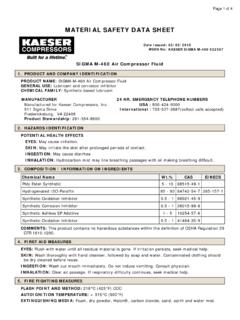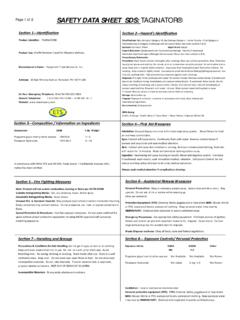Transcription of Product Name: Crude Oil , Sweet or Sour - EP Energy
1 safety data sheet : Crude Oil 1. Identification Product name : Crude Oil , Sweet or Sour Synonyms: Petroleum Oil, Crude , Sweet Crude Oil, Sour Crude Oil Product Use: Process stream, intended for fuel and lubricant production EP Energy 1001 Louisiana Street Information: (713) 997-1000 or 855-269-0826. Houston, Texas 77002 O'BRIEN'S: (985) 781-0804 24/7. 2. Hazard(s) Identification Note: This Product has not been tested by EP Energy to determine its specific health hazards. Therefore, the information provided in this section includes health hazard information on the Product components. GHS Classification H224: Flammable liquid Category 1. H304: Aspiration hazard H316: Skin irritation H319: Serious eye damage/irritation Category 2. H335: Specific target organ toxicity Category 3. H336: Specific target organ toxicity (single exposure) Category 3. H350: Carcinogenicity Category 1B.
2 H373: Specific target organ toxicity (repeated exposure) Category 2 (bone marrow, liver, thymus). H411: Hazardous to the aquatic environment, long term hazard Category 2. May contain or release poisonous hydrogen sulfide gas Hazards Not Otherwise Classified GHS Label Elements Signal Words Danger GHS Hazard Statements H224: Extremely flammable liquid and vapor H350: May cause cancer H304: May be fatal if swallowed and enters airways H319: Causes serious eye irritation H336: May cause drowsiness or dizziness H373: May cause damage to organs through prolonged or repeated exposure H316: Causes mild skin irritation H402: Harmful to aquatic life H411: Toxic to aquatic life with long lasting effects GHS Precautionary Statements P201: Obtain special instructions before use P202: Do not handle until all safety precautions have been read and understood P210: Keep away from heat/sparks/open flames/hot surfaces no smoking P233: Keep container tightly closed P240: Ground/bond container and receiving equipment P241.
3 Use explosion-proof electrical/ventilating/lighting equipment P242: Use only non-sparking tools P243: Take precautionary measures against static discharge P261: Avoid breathing dust/fume/gas/mist/vapours/spray P264: Wash thoroughly after handling P270: Do not eat, drink or smoke when using this Product P271: Use only outdoors or in a well-ventilated area P273: Avoid release to the environment P280: Wear protective gloves/protective clothing/eye protection/face protection Date Prepared 06/01/2015 Page 1 of 9. safety data sheet : Crude Oil Response P361, P352, P362: IF ON SKIN OR HAIR: Remove/take off immediately all contaminated clothing. Wash with plenty of soap and water. Take off contaminated clothing and wash before reuse. P305, P351, P338: IF IN EYES: Rinse cautiously with water for several minutes. Remove contact lenses, if present and easy to do. Continue rinsing P313: If eye irritation persists, get medical advice/attention P301, P310: IF SWALLOWED: Immediately call a POISON CENTER or doctor/physician P331: Do NOT induce vomiting P304, P340: IF INHALED: Remove victim to fresh air and keep at rest in a position comfortable for breathing P312: Call a POISON CENTER or doctor/physician if you feel unwell P370, P378: In case of fire: Use dry chemical, carbon dioxide, or foam for extinction Storage P233: Keep container tightly closed P405: Store locked up Disposal P391: Collect spillage P501: Dispose of contents/container in accordance with local/regional/national/international regulations.
4 3. Composition/Information on Ingredients Note: Composition will vary with geographic location, geologic formation, temperature and pressure. Components CAS No. Wt%(1). Crude Oil (Petroleum) 8002-05-9 95-100. Toluene 108-88-3 0-20. Xylenes 1330-20-7 0-20. Ethyl benzene 100-41-4 0-4. Benzene 71-43-2 0-2. n-Hexane 110-54-3 0-5. Hydrogen Sulfide 7783-06-4 Varies (1). Normal composition ranges are shown. Concentrations are percent by weight, unless the constituent is a gas. Gas concentrations are in percent by volume. Crude oil can contain minor amounts of sulfur, nitrogen and oxygen containing organic compounds as well as trace amounts of heavy metals, such as mercury, arsenic, nickel, and vanadium. Naturally occurring radioactive materials (NORM) may also be present. Composition varies depending on the source of the Crude oil. 4. First-aid Measures Inhalation: If respiratory symptoms develop, move victim to fresh air.
5 Seek immediate medical attention if symptoms persist. If breathing has stopped and airway is clear, provide artificial respiration. Do not use mouth-to-mouth method if victim ingested the substance. Provide artificial respiration with the aid of a pocket mask equipped with a one-way valve or other proper respiratory medical device. Administer oxygen if breathing is difficult, if qualified. Seek immediate medical attention. Skin Contact: Remove and isolate contaminated clothing and shoes. Wash affected areas with soap and water. If irritation persists, seek medical attention. Decontaminate clothing before reuse. Eye Contact: Flush eyes with large amounts of water for at least 15 minutes, occasionally lifting the eyelids. Seek medical attention. Ingestion: DO NOT INDUCE VOMITING. If spontaneous vomiting occurs, place on the left side with head down to prevent aspiration of liquid into the lungs.
6 Have exposed individual rinse mouth thoroughly with water. Never give anything by mouth to an unconscious person. Do not leave victim unattended. Monitor for breathing difficulties. Seek immediate medical attention. Notes to Physician: This material may contain or liberate hydrogen sulfide. In high doses, hydrogen sulfide may produce pulmonary edema and respiratory depression or paralysis. 5. Fire-Fighting Measures NFPA Ratings: Health: 3 Flammability: 3 Reactivity: 0. Combustion Products: Highly dependent on combustion conditions. Fume, smoke, carbon monoxide, carbon dioxide, sulfur and nitrogen oxides, aldehydes and unburned hydrocarbons. Date Prepared 06/01/2015 Page 2 of 9. safety data sheet : Crude Oil General Fire Hazards: Flammable. Ignited by heat, sparks or flames or other sources of ignition. Flowing oil can be ignited by self-generated 3. static electricity.
7 Containers should be grounded and bonded. Vapors may reach an ignition source and flashback. Runoff to sewer may create fire or explosion hazard downstream from the source. When mixed with air and exposed to 2 0. an ignition source, vapors can burn in the open or explode in confined spaces. BLEVE'S (Boiling Liquid Expanding Vapor Explosions) can occur when a liquid in a pressurized container is heated to temperatures beyond its boiling point. This can lead to failure of the container and damage to the surrounding area. Hazardous combustion/decomposition products may include carbon monoxide, carbon dioxide and hydrocarbons. Hydrogen sulfide may be present. Downwind personnel must be evacuated. Extinguishing Media: Suitable extinguishing media: dry chemical, foam, carbon dioxide, water spray. Carbon dioxide can displace oxygen. Use caution when applying carbon dioxide in confined spaces.
8 For large fires, use unmanned hoses. Water may be ineffective on large fires, but should be used to cool surrounding areas. Unsuitable extinguishing media: none. Fire Fighting Instructions: Move containers from fire area if you can do it without risk. Use a water spray to cool fire-exposed containers until well after fire is out. Do not direct water at source of leak or safety devices as icing may occur. Dike fire-control water for later disposal; do not scatter the material. Firefighters should wear self-contained breathing apparatus. Refer to Section 8 for proper PPE selection. Precautions for Fire Involving Tanks or Car/Trailer Loads: If tank, rail car or tank truck is involved in a fire, ISOLATE for 800 meters (1/2 mile) in all directions. Consider initial evacuation for 800 meters (1/2 mile) in all directions. Always stay away from tanks engulfed in flame. Fight fire from maximum distance or use unmanned hose holders or monitor nozzles.
9 Cool containers with flooding quantities of water until well after fire is out. Withdraw immediately in case of rising sound from venting safety devices or discoloration of tank. If unmanned hose holders or monitor nozzles cannot be used, withdraw from area and let fire burn. 6. Accidental Release Measures Personal Precautions: Extremely Flammable. Spillage of liquid Product will create a fire hazard and may form an explosive atmosphere. Keep all sources of ignition and hot metal surfaces away from spill/release. The use of explosion-proof electrical equipment is recommended. Product may contain or release poisonous hydrogen sulfide gas. Provide sufficient ventilation in the affected area(s) and wear appropriate personal protective equipment as indicated in Section 8 when handling spill material. Environmental Precautions: Stop the leak if it can be done without risk.
10 Prevent spilled material from entering waterways, sewers, basements or confined areas. Contain release to prevent further contamination of soils, surface water or groundwater. Clean up spill as soon as possible using appropriate techniques such as applying non-combustible absorbent materials or vacuuming. All equipment used when handling the Product must be grounded. A vapor suppressing foam may be used to reduce vapors. Use clean nonsparking tools to collect absorbed material. Where feasible and appropriate, remove contaminated soil. Methods for Containment and Clean Up: Immediate cleanup of any spill is recommended. Build dike or use other appropriate spill response methods far ahead of spill for containment and later recovery or disposal of spilled material. Absorb spill with inert material and place in suitable container for disposal. If spilled on water, remove with appropriate equipment such as skimmers, booms or absorbents.







